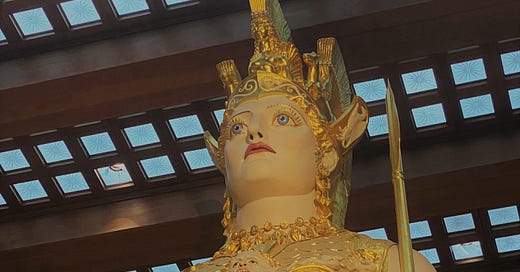


Of Pallas Athena, guardian of the city, I begin to sing. Dread is she, and with Ares she loves the deeds of war, the sack of cities and the shouting and the battle. It is she who saves the people as they go to war and come back. Hail, goddess, and give us good fortune and happiness!
- Homeric Hymn 11 to Athena (trans. Evelyn-White)
History
The Nashville Parthenon was originally built during the state of Tennessee’s 100th anniversary of statehood in 1897. Intended to be a temporary structure to celebrate Nashville’s title as the “Athens of the South”, the Parthenon soon found great popularity with the residents of the city. Many parts were made of cheap materials such as plaster and needed to be repeatedly fixed until the city began the long process of investing in construction. The doors of the finalized version opened to the public in 1931. The 42 foot statue of Athena was added much later and unveiled the to public in 1990, and her final gilding and paint was completed by 2002.
The site is a replica of the original temple in Athens, Greece. Many figures were cast from their originals across the sea. In addition to the giant statue of the goddess, the pediments above the buildings depict critical scenes in the life of Athena such as her crowning with laurel leaves after a victory over the Persians and her being chosen over Poseidon as the patron of Athens because her gift of an olive tree was perceived as more valuable. Many other gods and goddess are depicted alongside her in these mythic scenes.
Spiritual Value
Finding places that offer even a semblance of the grandeur a worshipper in the ancient world would have experienced is exceedingly difficult. The closest many come is seeing the classically inspired artwork at a local court courthouse or state capitol building. There is a certain sensation of awe in the presentation alone.
The goddess Athena is beautiful to behold. She is depicted with the winged goddess of victory Nike in her hand. Her shield rests powerfully at her side with the head of Medusa displayed. I particularly like the shield as the gorgon head isn’t objectively beautiful by current western standards but instead looks ahead with the intimidating fierceness they were known for in the ancient world.
While historically accurate with its exhibitions, the Parthenon is meant first and foremost as an art museum and educational facility. While many people gather and look up at the statue of Athena in awe, it’s almost certainly not with the air of reverence she would have experienced in the ancient world. The exhibits when I visited were buzzing with the energy of other tourists, making it difficult to meditate to tune in with the presence of the goddess but perhaps this is because my principal devotion is not with Athena.
I still highly recommend the site for those interested in the Greek gods and goddesses. The layout of the temple can be used to help with re-creating her temple for inner journey work outside of the main trip. Close your eyes and visualize wandering through the temple in its prime, populated primarily by priestesses. Imagine the burning of offerings and prayers sincerely offered as a sea breeze floats in on the air. Surely this was something to behold.
Additional Notes
The Parthenon also hosts other art exhibitions in the building which are worth looking through. The area is within Centennial Park which offers lots of walking paths along a pond. Parking was crowded when I visited but manageable with some walking required. When going to enter the building, the entrance is at ground level rather than up the steps so avoid the mistake I made wandering around the grounds confused looking for where to go in.
Visiting Information
Address: 2500 West End Ave, Nashville, TN 37203
https://www.nashvilleparthenon.com/
Cost to Visit at Time of Writing: $10 per adult





